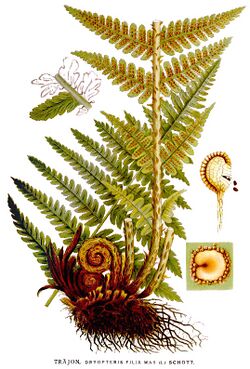Biology:Dryopteris filix-mas
| Dryopteris filix-mas | |
|---|---|

| |
| Scientific classification | |
| Kingdom: | Plantae |
| Clade: | Tracheophytes |
| Division: | Polypodiophyta |
| Class: | Polypodiopsida |
| Order: | Polypodiales |
| Suborder: | Polypodiineae |
| Family: | Dryopteridaceae |
| Genus: | Dryopteris |
| Species: | D. filix-mas
|
| Binomial name | |
| Dryopteris filix-mas | |
Dryopteris filix-mas, the male fern,[1] is a common fern of the temperate Northern Hemisphere, native to much of Europe, Asia, and North America. It favours damp shaded areas in the understory of woodlands, but also shady places on hedge-banks, rocks, and screes. Near the northern limit of its distribution it prefers sunny, well-drained sites. It is much less abundant in North America than in Europe. The plant is sometimes referred to in ancient literature as worm fern, reflecting its former use against tapeworm.
Its specific epithet filix-mas means "male fern" (filix "fern", mas "male"), as the plant was thought to be the male version of the common lady fern Athyrium filix-femina.[2] being robust in appearance and vigorous in growth.[3]
Description
The semi-evergreen leaves have an upright habit and reach a maximum length of 150 cm (59 in), with a single crown on each rootstock. The bipinnate leaves consist of 20–35 pinnae on each side of the rachis. The leaves taper at both ends, with the basal pinnae about half the length of the middle pinnae. The pinules are rather blunt and equally lobed all around. The stalks are covered with orange-brown scales. On the abaxial surface of the mature blade 5 to 6 sori develop in two rows. When the spores ripen in August to November, the indusium starts to shrivel, leading to the release of the spores.
This species hybridises easily with Dryopteris affinis (scaly male fern) and Dryopteris oreades (mountain male fern).
Cultivation and uses
Numerous cultivars have been selected for garden use. The following have gained the Royal Horticultural Society's Award of Garden Merit:[4]
Culture
D. filix-mas is culturally named the title plant of Nurmijärvi, the municipality in Uusimaa, Finland . The reason is that the plant is related to the first Finnish pharmaceutical factory located in Nurmijärvi in 1899–1964. The pharmaceutical factory founded by the pharmacist Albin Koponen made Diphyllobothrium latum and cestoda medicines called Filisin and Filicon, the raw material of which was the rhizome of D. filix-mas. The rhizomes were still collected in the locality in the 1960s.[10]
References
- ↑ (xls) BSBI List 2007, Botanical Society of Britain and Ireland, https://bsbi.org/download/3542/, retrieved 2014-10-17
- ↑ Collins English Dictionary – Complete & Unabridged 10th Edition, 2009: "C16: so called because it was formerly believed to be the male of the lady fern"
- ↑ Wayside and Woodland Blossoms (1895) by Edward Step: "the Male-fern – so-called by our fathers owing to its robust habit as compared with the tender grace of one they called Lady-fern."
- ↑ "AGM Plants – Ornamental". Royal Horticultural Society. July 2017. p. 33. https://www.rhs.org.uk/plants/pdfs/agm-lists/agm-ornamentals.pdf.
- ↑ "RHS Plantfinder – Dryopteris filix-mas". https://www.rhs.org.uk/Plants/114462/i-Dryopteris-filix-mas-i/Details.
- ↑ "RHS Plantfinder – Dryopteris filix-mas 'Crispa Cristata'". https://www.rhs.org.uk/Plants/94168/i-Dryopteris-filix-mas-i-Crispa-Cristata/Details.
- ↑ "RHS Plantfinder – Dryopteris filix-mas 'Cristata'". https://www.rhs.org.uk/Plants/6185/i-Dryopteris-filix-mas-i-Cristata/Details.
- ↑ "RHS Plantfinder – Dryopteris filix-mas 'Grandiceps Wills'". https://www.rhs.org.uk/Plants/87557/i-Dryopteris-filix-mas-i-Grandiceps-Wills/Details.
- ↑ "RHS Plantfinder – Dryopteris filix-mas 'Linearis Polydactyla'". https://www.rhs.org.uk/Plants/99759/i-Dryopteris-filix-mas-i-Linearis-Polydactyla/Details.
- ↑ Vaakuna ja tunnukset - Nurmijärvi.fi (in Finnish)
External links
- Flora Europaea: Dryopteris filix-mas
- Flora of North America: Dryopteris filix-mas
- Jepson Manual Treatment
Wikidata ☰ Q322994 entry
 |


